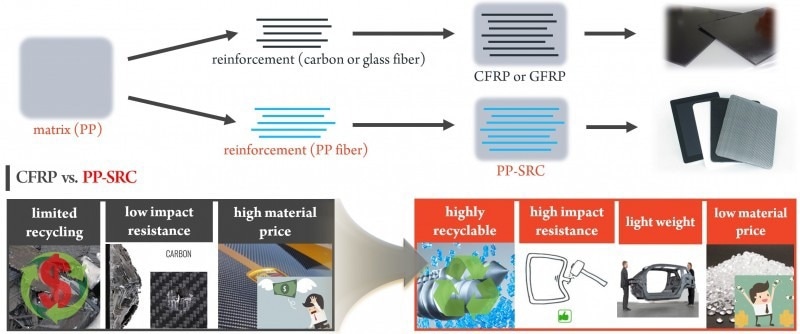For future mobility, like urban air mobility (UAM), to become mainstream, it must be fuel-efficient and have low carbon emissions. Such a development requires the design of novel materials with outstanding physical properties and recyclability.
 Definition and benefits of polypropylene (PP) self-reinforced composites. Image Credit: Korea Institute of Science and Technology.
Definition and benefits of polypropylene (PP) self-reinforced composites. Image Credit: Korea Institute of Science and Technology.
Self-reinforced composites (SRCs) are cheap, lightweight, and have benefits in terms of recycling and disposal because the strengthening and the base material are made of the same material. Consequently, SRCs are gaining focus as a next-generation composite material to exchange carbon fiber-reinforced composites employed in airplanes.
Korea Institute of Science and Technology (KIST) has announced that Dr. Jaewoo Kim of the Solutions to Electromagnetic Interference in Future-mobility(SEIF), along with Prof. Seonghoon Kim of Hanyang University and Prof. O-bong Yang of Jeonbuk National University has efficiently built a 100% SRC with the use of only one kind of polypropylene (PP) polymer.
So far, in the production process of SRCs, chemically varied components have been combined in the strengthening or matrix to enhance impregnation and fluidity, leading to poor physical properties and recyclability. The team were able to regulate the fluidity, melting point, and impregnation by fine-tuning the chain structure of the polypropylene matrix via a four-axis extrusion process.
The developed SRCs gained the highest level of mechanical properties, with adhesion strength, tensile strength, and impact resistance enhanced by 333%, 228%, and 2,700%, respectively, compared to earlier research studies. Upon application as a frame material for a small drone, the material was 52% lighter compared to traditional carbon fiber reinforced composites and the flight time improved by 27%, authorizing its likelihood for next-generation mobility applications.
The engineering process for 100% SRCs developed in this study can be immediately applied to industry, and we will continue to work with the joint research team and industries to secure the global competitiveness of magnetically reinforced composites.
Dr. Jaewoo Kim, Korea Institute of Science and Technology